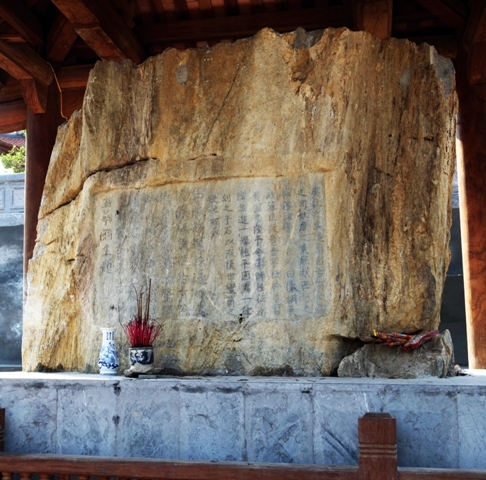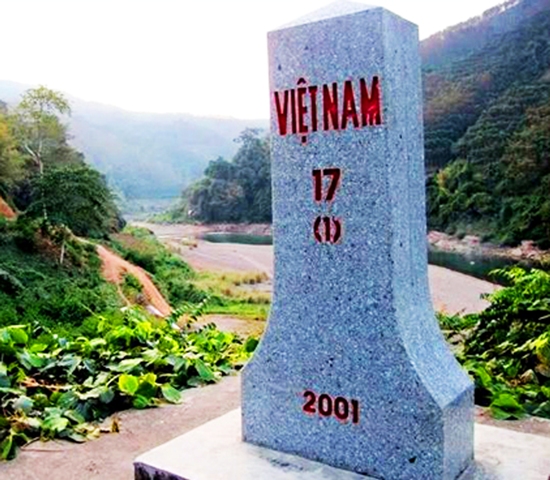Saying that we go upstream the Black river is just an exaggeration. Basically we only went along the left bank of this swift river to discover its historical mysteries. In fact, to successfully accomplish this adventure was already a miracle to us. Lai Chau can be called the best place to challenge people in self-improving and self-discovery.

The Black
river looks like a red thread
From the historical documents, I
know that after defeating the Ming invaders and won back the independence in
1432, King Le Loi marched upstream the Black river to pacify the Deo Cat Han insurrection
and on his way back, he had the poem “Than chinh Phuc Le chau Deo Cat Han” engraved
on stones. It remains mystical to this day how King Le Thai To engraved that
poem with his sword. Witnessing that poem after nearly 600 years of existence,
we were still very impressed. Some even doubt the story of Le Loi and his upstream
march using primitive means of transportation. Still, there are a lot of
historical evidence proving the truth of this story. It clearly demonstrated the
will and determination of our forefathers in protecting the country. During the
construction of the Son La hydropower plant, the stele was relocated
approximately 500 meters away from the previous location on the provincial road
to Muong Te – Lai Chau. The stele’s direction is towards the Black
river, facing both the road and the waterways. At this moment the stele
was part of the architectural complex of temple King
Le Loi.
.jpg)
A small ethnic minority village in the riverside
Toward the legendary Muong Lay
crossroad, the Black river met Nam Na stream –
the famous ruined palace of the Thai King Deo Van Long. The local people shared
with us lots of mystical stories about that King such as he worked as the
minion for French enemy to kill local citizens; the brutality even to his
children; the lavish wealth; the frequency of over-night parties with beautiful
girls. Standing on the remains of one of the most luxurious palaces in the past
and looking at the confluence, the travelers will see peaceful sky keeping them
in this place.
The Black
river has now been conquered and brings the largest amount of
hydropower resources than any other river nationwide. It has become a gentle river
with a large wavy surface.
From the confluence, along the left
bank of the Black river, going to Provincial Highway
127 about 100 km, we reached Muong Te town. Along the sinuous but amazing road,
there are always hidden dangers as the road run between steep cliffs and deep
abysses with red, aggressive currents. There are some river cliffs with
monstrous shapes, eroded away by the strong currents in long ages.
From the town, along the river and
go back 40 km, we will reach Nam Lan intersection. Passing around 20 km more,
we went to Keng Mo border station. The sightseeing is
fantastic when Black river looks like the
thread between both sides of towering mountains. However, the journey is
extremely difficult. In the 20 km road, the strong will and determination of
each traveler was really challenged.
After 3 hours experiencing on each
curve, finally travelers reached Keng
Mo border station.

King Le Loi stele
Through the suspension bridge next
to Keng Mo
station and continued going in appropriately 5 km, we reached the confluence
when border post no. 17 was put. This is the place where Black river started flowing
into Vietnam. As researched, we know this ferocious river flows
in the steep basin and full of challenging falls to any boat. For these reasons, the “Black
river ferrymen” have named some falls to describe the aggressiveness
such as: “Kẻng Cớn” means rolling stone; “Kẻng Mỏ” means flipped boats. In the
narrow border confluence with more than 100m width, water is very cold and swift.
The riverside is full of rocks, many of them have strange shapes like human
foot with different beautiful colors.

After a very arduous journey, we
finally conquered the last border post of the Northwest. Standing here, we felt
not only proud but also impressed and admired our forefathers for fighting to
preserve our beautiful country. This river is also the place of starting
culture of the ethnic people. It has nourished and enriched the noble
traditions of our nation and witnessed the legends of Vietnamese. Recalling the
journey, I suddenly remember two sentences in a great poem:
“Chung thủy giai Đông
tẩu
Đà Giang độc bắc
lưu”.
Thái Hà
Translator: Thu Phuong